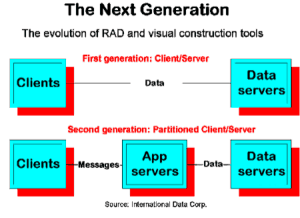| |

The RAD paradigm becomes more, not less, important as we move from two-to three-tier development. Scott Hebner, IBM Software
|
|
|
|
The Midas Touch
Borland's blend of RAD and Midas middleware lets Midwestern
integrator tackle a $40-million n-tier project.
Cris Ross knows from experience that RAD tools aren't just for pretty GUIs
anymore. The president of Artemis Alliance, a five year old, 35-person
custom software integrator in St. Paul, MN, specializes in client/server and
multitier development for government and commercial clients.
Ross also happens to be lead consultant on a large project for the Minnesota
Department of Human Services. Using Borland's Delphi (and the Midas middleware
extensions built into the current version of Delphi tools), Artemis is helping
build a system capable of supporting 2,500 users distributed among 100 different
servers.
 |
|
Minnesota integrator, Cris Ross uses the new generation
of RAD tools to ease his state's growing pains.
|
The $40-million project, begun last July and slated for completion by year-end
1998, cried out for a three-tier implementation, says Ross. Each county in Minnesota
maintains its own data on Human Services clients, he explains, so 100 separate
servers are required.
However, the rules that drive how each county is supposed to manage its caseload
come from the state and federal governments, so all these servers work from
a single, constantly updated rules engine. The 3,000 child welfare caseworkers
that use the system are scattered across the state and they needed a maintenance-free
thin-client application.
Spared The Usual Headaches
The Midas middleware tools provided an easy way to pull this off, says
Ross. We created a flexible and robust middle layer quickly, while facilitating
connectivity to all major database platforms. In this particular project,
hooks to an Oracle relational database were key, as was the ability
to write a thin-client app for the Windows 95 PCs of caseworkers.
Midas also let Artemis developers interact with remote data sets using
the same Delphi components they employ for two-tier client/server coding.
And Delphi's support for COM, DCOM, and TCP/IP is superb, says Craig Johnson,
a principal architect on the project. It saves us from the usual headaches
of hooking NT servers and thin clients together.
In this case, Johnson and his team wrote the hooks using the DCOM tools
they were most familiar with. When it was time to add TCP/IP, Delphi did
it automatically-no program changes required.
Who's Ready For n Tier?
If Delphi makes n-tier development so easy, why aren't more of Artemis's projects
n tier? The tools may be ready for n tier development, Johnson warns, but not
all customers are.
Because n tier requires a different type of analysis than does client/server,
Johnson explains, you're forced to think deeply about how to pool
sessions and manage security most efficiently It gets even more complicated
with the distributed-logic requirements for thin clients.
This deeper level of planning and testing demands more time, which translates
into higher project costs for n-tier applications. Many corporate development
budgets aren't prepared for these costs, even if Artemis is ready to deliver.
|



